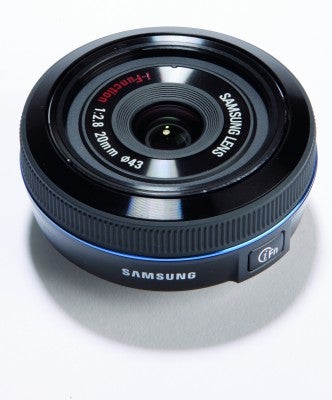The Samsung 20mm f/2.8 NX iFunction Pancake will have real size benefits when paired with a CSC body
Samsung 20mm f/2.8 NX iFunction Pancake Review
Aesthetically, the result is very pleasing but the ultra-short lens barrel means compromises have to be made.
There is just one push-button switch and one rotating ring on Samsungs 20mm pancake lens: they are used to activate and control the cameras iFunction system respectively. This means there appears to be no facility to focus the lens manually – but in fact that is an illusion because when MF is set on the camera body the iFunction ring acts as a focusing ring until the iFunction button is pressed. (To activate the iFunction ring for manual focusing in AF mode it is necessary to select DMF in on a different menu page from the one that is used to select the AF mode, which seems a little strange.)
Given that Samsungs NX cameras use a larger-than-average APS-C format sensor, the conversion factor used to work out 35mm-equivalent lenses is just 1.5x, which gives the 20mm lens tested here the same angle-of-view as a 30mm lens used on a full-frame camera body.
This is a very versatile and useful coverage that can be employed for a wide range of subjects, from landscapes to environmental portraiture. The maximum aperture (f/2.8) is wide enough to give good separation between in-focus subjects and out-of-focus backgrounds.
Technical testing returned slightly lower MTF figures at wide apertures but this is consistent with the classic aerofoil profile and the figures remained above the critical 0.25 cycles-per-pixel level from f/2.8 to f/11.
The same was not true at f/22 but even here the MTF remained acceptable (0.22 cycles-per-pixel). There were slight signs of chromatic aberration visible on the test targets but nothing significant.
Real-world use of the lens proved highly satisfying, not least because its angle-of-view matches the area that the human eye concentrates on when absorbing a scene. This means the composition on the camera screen is consistent with the way the scene was originally viewed.
As somebody who used to love using a Ricoh GR-1 film-based camera with its fixed 28mm lens, the combination used here, of a Samsung NX200 body with the 30mm-equivalent 20mm lens, proved immediately rewarding and produced some very pleasing photographs.





